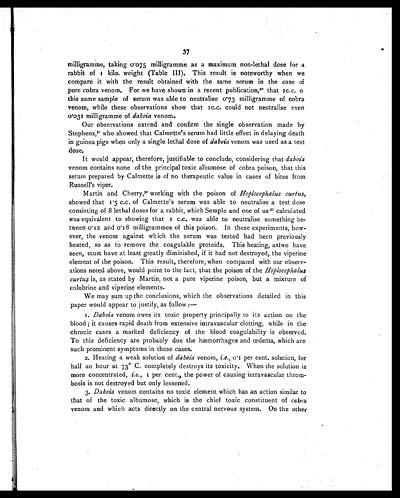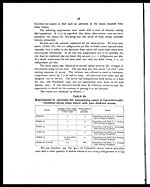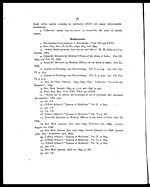Medicine - Institutions > Army health reports and medical documents > Scientific memoirs by officers of the Medical and Sanitary Departments of the Government of India > Number 3 - Some observations on the poison of Russell's viper (Daboia russellii) > Some observations on the poison of Russell's viper (Daboia russellii)
(43) Page 37
Download files
Individual page:
Thumbnail gallery: Grid view | List view

37
milligramme, taking 0.075 milligramme as a maximum non-lethal dose for a
rabbit of 1 kilo. weight (Table III). This result is noteworthy when we
compare it with the result obtained with the same serum in the case of
pure cobra venom. For we have shown in a recent publication,30 that 1 c.c. 0
this same sample of serum was able to neutralise 0.73 milligramme of cobra
venom, while these observations show that 1c.c. could not neutralise even
0.031 milligramme of daboia venom.
Our observations extend and confirm the single observation made by
Stephens,31 who showed that Calmette's serum had little effect in delaying death
in guinea pigs when only a single lethal dose of daboia venom was used as a test
dose.
It would appear, therefore, justifiable to conclude, considering that daboia
venom contains none of the principal toxic albumose of cobra poison, that this
serum prepared by Calmette is of no therapeutic value in cases of bites from
Russell's viper.
Martin and Cherry,32 working with the poison of Hoplocephalus curtus,
showed that 1.5 c.c. of Calmette's serum was able to neutralise a test dose
consisting of 8 lethal doses for a rabbit, which Semple and one of us 33 calculated
was equivalent to showing that 1 c.c. was able to neutralise something be-
tween 0.12 and 0.18 milligrammes of this poison. In these experiments, how-
ever, the venom against which the serum was tested had been previously
heated, so as to remove the coagulable proteids. This heating, aslwe have
seen, must have at least greatly diminished, if it had not destroyed, the viperine
element of the poison. This result, therefore, when compared with our observ-
ations noted above, would point to the fact, that the poison of the Hoplocephalus
curtus is, as stated by Martin, not a pure viperine poison, but a mixture of
colubrine and viperine elements.
We may sum up the conclusions, which the observations detailed in this
paper would appear to justify, as follow :—
1. Daboia venom owes its toxic property principally to its action on the
blood; it causes rapid death from extensive intravascular clotting, while in the
chronic cases a marked deficiency of the blood coagulability is observed.
To this deficiency are probably due the hæmorrhages and œdema, which are
such prominent symptoms in these cases.
2. Heating a weak solution of daboia venom, i.e., 0.1 per cent. solution, for
half an hour at 73°C. completely destroys its toxicity. When the solution is
more concentrated, i.e., 1 per cent., the power of causing intravascular throm-
bosis is not destroyed but only lessened.
3. Daboia venom contains no toxic element which has an action similar to
that of the toxic albumose, which is the chief toxic constituent of cobra
venom and which acts directly on the central nervous system. On the other
Set display mode to: Large image | Zoom image | Transcription
Images and transcriptions on this page, including medium image downloads, may be used under the Creative Commons Attribution 4.0 International Licence unless otherwise stated. ![]()
| Permanent URL | https://digital.nls.uk/75023730 |
|---|
| Shelfmark | IP/QB.10 |
|---|---|
| Additional NLS resources: | |




